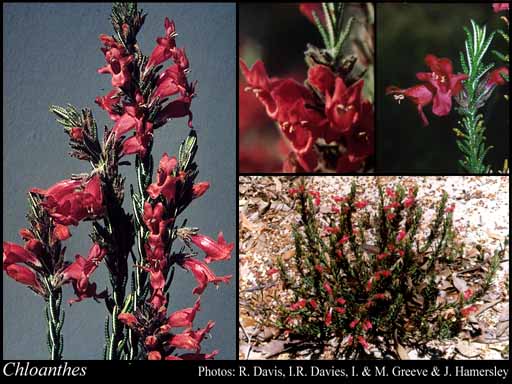- Reference
- Prodr.Fl.Nov.Holland. 513 (1810)
- Name Status
- Current

Scientific Description
Family Lamiaceae.
Sometimes included in Chloanthaceae, Verbenaceae.
Habit and leaf form. Shrubs (undershrubs); evergreen; resinous (viscid or glutinous), or not resinous. ‘Normal’ plants to switch-plants (somewhat switch-plant-like, owing to sparse leaves and broom-like habit). Leaves well developed, or much reduced. Plants with roots; unarmed. Leaves cauline. Young stems cylindrical. Stem internodes solid (woody). To 0.25–0.9 m high. Leaves small; opposite, or whorled; decussate; 3 per whorl; decurrent on the stems; leathery; sessile; aromatic, or without marked odour; simple. Leaf blades entire; solid (almost terete); semi-terete; narrow- linear; narrow- linear; pinnately veined; cross-venulate. Mature leaf blades adaxially distinctly bullate-rugose; abaxially woolly (except C. glandulosa). Leaves without stipules. Leaf blade margins crenate; revolute. Leaves without a persistent basal meristem. Leaf anatomy. Hairs present; glandular hairs absent; complex hairs present, or absent. Branched hairs absent. Complex hairs stellate. Stem anatomy. Secondary thickening anomalous; via concentric cambia.
Reproductive type, pollination. Fertile flowers hermaphrodite. Unisexual flowers absent. Plants hermaphrodite. Plants heterostylous.
Inflorescence and flower features. Flowers solitary; axillary. Inflorescences flowers axillary, solitary. Flowers pedicellate, or subsessile. Pedicels terete. Flowers bracteate; bracteolate. Bracteoles not adnate to the receptacle. Flowers medium-sized; very irregular; zygomorphic. The floral asymmetry involving the perianth and involving the androecium. Flowers 5 merous; cyclic; tetracyclic. Free hypanthium absent. Hypogynous disk absent. Perianth with distinct calyx and corolla; 10; 2 -whorled; isomerous. Perianth members entire. Calyx present; 5(–6); 1 -whorled; gamosepalous; deeply 5- blunt-lobed, or toothed; exceeded by the corolla; cyathiform; regular; persistent; non-accrescent. Corolla present; 5; 1 -whorled; gamopetalous; blunt-lobed; imbricate; bilabiate; hairy abaxially; green to yellow, or green to cream, or red, or purple (pale mauve with purple spots); deciduous. Corolla lobes more or less ovate (upper lip 2-lobed, lower 3-lobed, lobes spreading, the anterior one (i.e. middle lobe of lower lip) larger than others). Androecium present. Androecium 4. Androecial members adnate (epipetalous); markedly unequal; free of one another; 1 -whorled. Androecium exclusively of fertile stamens. Stamens 4. Staminal insertion near the base of the corolla tube. Stamens didynamous (somewhat); all more or less similar in shape; reduced in number relative to the adjacent perianth; fertile stamens representing the posterior-lateral pair and the anterior-lateral pair; oppositisepalous. Filaments hairy; filiform. Anthers dorsifixed; dehiscing via longitudinal slits. Gynoecium 2 carpelled. The pistil 4 celled. Carpels reduced in number relative to the perianth. Gynoecium syncarpous; synstylovarious (styles free in upper part); superior. Ovary plurilocular; 2 locular (morphologically), or 4 locular (ostensibly, via false septa). Locules secondarily divided by ‘false septa’. Gynoecium median. Ovary summit hairy, the hairs not confined to radiating bands. Gynoecium stylate. Styles 1; simple; apical; much longer than the ovary at anthesis; hairless (glabrous). Stigmas 2; 2 - lobed. Placentation axile. Ovules 1 per locule (ostensibly, i.e. 1 per locellus), or 2 per locule (per carpel); non-arillate; hemianatropous.
Fruit and seed features. Fruit falling from the plant before the next growing season; non-fleshy; indehiscent; a drupe. The drupes with separable pyrenes (two). Fruit 4 celled; 4 locular. Endocarp not ribbed. Dispersal unit the mericarp. Fruit 1–4 seeded. Seeds 2 or more per mericarp (2). Seeds endospermic. Embryo straight.
Special features. Calyx limb 5(–6) lobed. Corolla tube exceeding the calyx; straight to curved. The upper lip of the corolla incorporating 2 members, the lower 3; (posterior, adaxial) lip of the corolla bilobed; upper (adaxial) lip of the corolla not concave. Lower (abaxial) lip of the corolla 3 lobed; not concave. Stamens projecting straight forwards or spreading, or descending. The anterior pair of stamens exceeding the posterior pair.
Geography, cytology, number of species. Native of Australia. Endemic to Australia. Australian states and territories: Western Australia, Queensland, and New South Wales. South-West Botanical Province. A genus of 4 species; 1 species in Western Australia; 1 endemic to Western Australia.
Etymology. From the Greek for "greenish-yellow, pale green" and "flower"; the original specimens dried greenish.